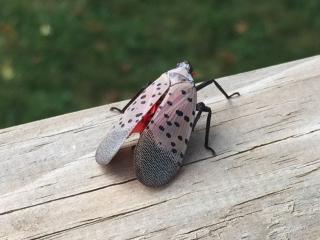Bad Bug: The Spotted Lanternfly

Have you heard of the Spotted Lanternfly? Most people are at least somewhat familiar with this colorful insect, or have heard about it in the news. This invasive insect from Asia was first discovered in the United States in 2014 in Berks County, PA. Since then it has continued to spread and has now been found in 34 Pennsylvania counties along with the neighboring states of Delaware, New Jersey, and New York. It has not yet been discovered in Ferguson Township, or Centre County but the 3 counties to the South of us (Blair, Huntingdon, Mifflin) do have confirmed infestations.
The Spotted Lanternfly is not a danger to humans or pets, but it is a large concern for native trees and agriculture. This insect feeds on the sap of over 70 pant species, some of its favorites are apple trees, grapevines, black walnut, and birch.
The Spotted Lanternfly on its own typically will not kill a tree, but when feeding pressure is combined with other pests, drought, or other tree stressors, tree mortality becomes more likely. A secondary problem of the spotted lanternfly is what it leaves behind as it feeds. Spotted Lanternfly excretes honeydew (a sugary substance) which can attract other insects such as bees and wasps. Honeydew also promotes the growth of sooty mold which can cover anything below the tree canopy such as cars, sidewalks, patios, etc.
As we move into Spring and Summer please keep a look out for these invasive pests. If you think you may have found a Spotted Lanternfly, please take a picture of it and report your finding to the Pennsylvania Department of Agriculture at 1-888-4BADFLY.

